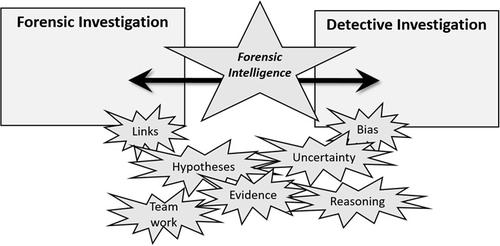当前位置:
X-MOL 学术
›
WIREs Data Mining Knowl. Discov.
›
论文详情
Our official English website, www.x-mol.net, welcomes your feedback! (Note: you will need to create a separate account there.)
Forensic intelligence and the analytical process
WIREs Data Mining and Knowledge Discovery ( IF 7.8 ) Pub Date : 2020-01-27 , DOI: 10.1002/widm.1354 Giles Oatley 1 , Brendan Chapman 2 , James Speers 2
WIREs Data Mining and Knowledge Discovery ( IF 7.8 ) Pub Date : 2020-01-27 , DOI: 10.1002/widm.1354 Giles Oatley 1 , Brendan Chapman 2 , James Speers 2
Affiliation

|
A review was undertaken of the developments made with integrating forensic evidence into the analytical process to support police investigations. Evidence such as DNA, fingerprints, fibers, accelerants, tyre marks, and so forth, can support to differing degrees the various working theories or hypotheses about the nature of the alleged crime, the persons of interest and the modus operandi. Investigators however, either forensic or detective, bring various biases to evidence capture and analysis, biases which are better understood in the intelligence community. Structured analytical techniques have a long history in intelligence analysis, for example analysis of competing hypotheses, which serves several purposes: information sharing, clarity of communication, and to highlight the common forms of bias brought to bear in an investigation. We illustrate the representation of links based on traces and intelligence, and how these can be stored in databases permitting better “reasoning” with evidence. We also present some recommendations for integration of forensic intelligence into the investigative analytic process and review information systems in this area.
中文翻译:

法医情报和分析过程
对将法医证据纳入分析过程以支持警察调查所取得的进展进行了审查。诸如DNA,指纹,纤维,促进剂,轮胎痕迹等的证据可以在不同程度上支持有关所指称的犯罪的性质,相关人员和作案手法的各种工作理论或假设。但是,调查人员(无论是法医还是侦探)都会给取证和分析带来各种偏见,这些偏见在情报界中得到了更好的理解。结构化分析技术在情报分析中有很长的历史,例如对竞争假设的分析,它具有多个目的:信息共享,沟通的清晰性,以及强调调查中常见的偏见形式。我们将说明基于跟踪和情报的链接的表示形式,以及如何将其存储在数据库中以更好地“证明”证据。我们还提出了一些建议,将法医情报纳入调查分析过程并审查该领域的信息系统。
更新日期:2020-01-27
中文翻译:

法医情报和分析过程
对将法医证据纳入分析过程以支持警察调查所取得的进展进行了审查。诸如DNA,指纹,纤维,促进剂,轮胎痕迹等的证据可以在不同程度上支持有关所指称的犯罪的性质,相关人员和作案手法的各种工作理论或假设。但是,调查人员(无论是法医还是侦探)都会给取证和分析带来各种偏见,这些偏见在情报界中得到了更好的理解。结构化分析技术在情报分析中有很长的历史,例如对竞争假设的分析,它具有多个目的:信息共享,沟通的清晰性,以及强调调查中常见的偏见形式。我们将说明基于跟踪和情报的链接的表示形式,以及如何将其存储在数据库中以更好地“证明”证据。我们还提出了一些建议,将法医情报纳入调查分析过程并审查该领域的信息系统。



























 京公网安备 11010802027423号
京公网安备 11010802027423号